Capital Gains | Taxation Law | Assignment
VerifiedAdded on 2022/08/31
|6
|1132
|29
AI Summary
Contribute Materials
Your contribution can guide someone’s learning journey. Share your
documents today.
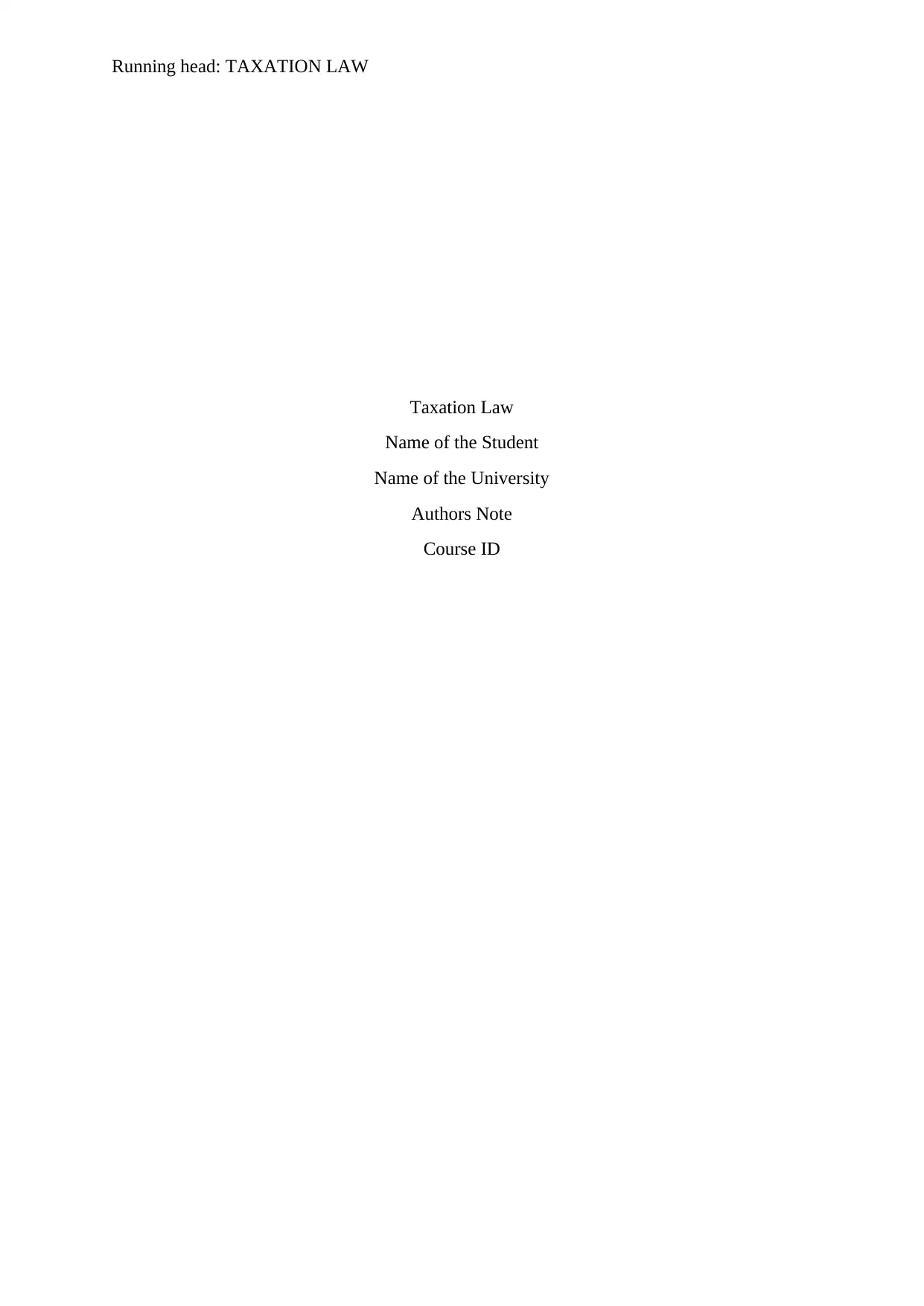
Running head: TAXATION LAW
Taxation Law
Name of the Student
Name of the University
Authors Note
Course ID
Taxation Law
Name of the Student
Name of the University
Authors Note
Course ID
Secure Best Marks with AI Grader
Need help grading? Try our AI Grader for instant feedback on your assignments.
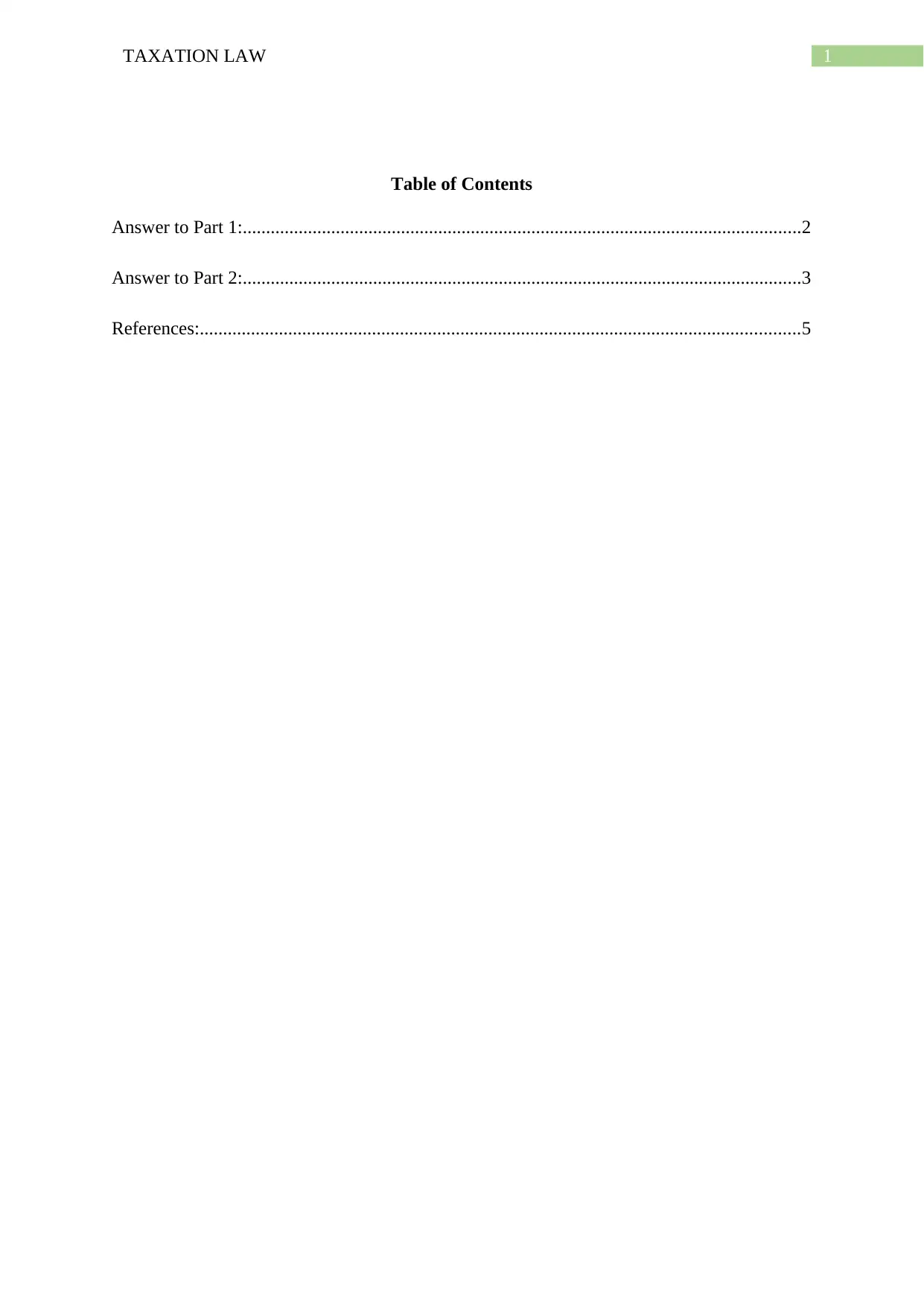
1TAXATION LAW
Table of Contents
Answer to Part 1:........................................................................................................................2
Answer to Part 2:........................................................................................................................3
References:.................................................................................................................................5
Table of Contents
Answer to Part 1:........................................................................................................................2
Answer to Part 2:........................................................................................................................3
References:.................................................................................................................................5
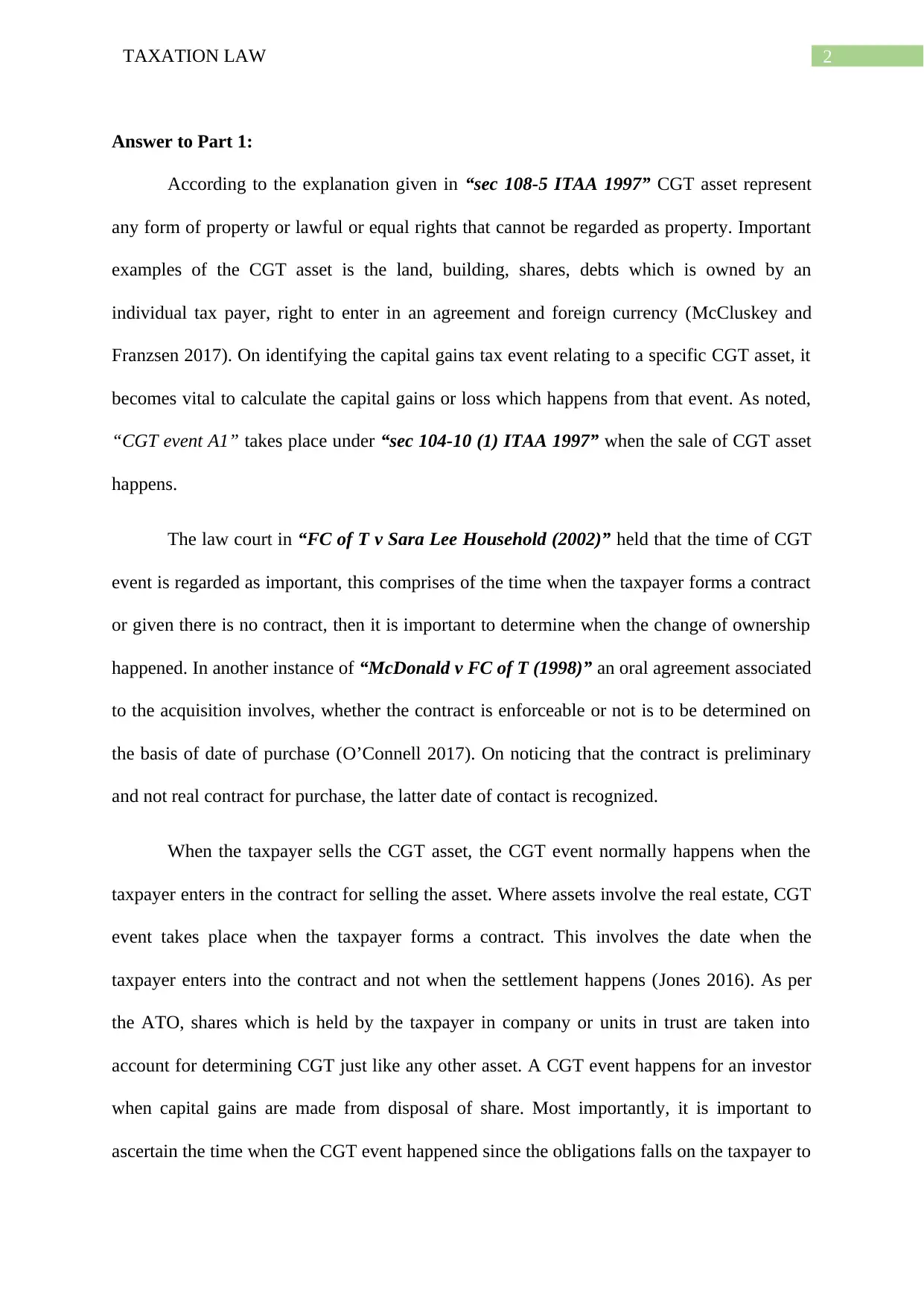
2TAXATION LAW
Answer to Part 1:
According to the explanation given in “sec 108-5 ITAA 1997” CGT asset represent
any form of property or lawful or equal rights that cannot be regarded as property. Important
examples of the CGT asset is the land, building, shares, debts which is owned by an
individual tax payer, right to enter in an agreement and foreign currency (McCluskey and
Franzsen 2017). On identifying the capital gains tax event relating to a specific CGT asset, it
becomes vital to calculate the capital gains or loss which happens from that event. As noted,
“CGT event A1” takes place under “sec 104-10 (1) ITAA 1997” when the sale of CGT asset
happens.
The law court in “FC of T v Sara Lee Household (2002)” held that the time of CGT
event is regarded as important, this comprises of the time when the taxpayer forms a contract
or given there is no contract, then it is important to determine when the change of ownership
happened. In another instance of “McDonald v FC of T (1998)” an oral agreement associated
to the acquisition involves, whether the contract is enforceable or not is to be determined on
the basis of date of purchase (O’Connell 2017). On noticing that the contract is preliminary
and not real contract for purchase, the latter date of contact is recognized.
When the taxpayer sells the CGT asset, the CGT event normally happens when the
taxpayer enters in the contract for selling the asset. Where assets involve the real estate, CGT
event takes place when the taxpayer forms a contract. This involves the date when the
taxpayer enters into the contract and not when the settlement happens (Jones 2016). As per
the ATO, shares which is held by the taxpayer in company or units in trust are taken into
account for determining CGT just like any other asset. A CGT event happens for an investor
when capital gains are made from disposal of share. Most importantly, it is important to
ascertain the time when the CGT event happened since the obligations falls on the taxpayer to
Answer to Part 1:
According to the explanation given in “sec 108-5 ITAA 1997” CGT asset represent
any form of property or lawful or equal rights that cannot be regarded as property. Important
examples of the CGT asset is the land, building, shares, debts which is owned by an
individual tax payer, right to enter in an agreement and foreign currency (McCluskey and
Franzsen 2017). On identifying the capital gains tax event relating to a specific CGT asset, it
becomes vital to calculate the capital gains or loss which happens from that event. As noted,
“CGT event A1” takes place under “sec 104-10 (1) ITAA 1997” when the sale of CGT asset
happens.
The law court in “FC of T v Sara Lee Household (2002)” held that the time of CGT
event is regarded as important, this comprises of the time when the taxpayer forms a contract
or given there is no contract, then it is important to determine when the change of ownership
happened. In another instance of “McDonald v FC of T (1998)” an oral agreement associated
to the acquisition involves, whether the contract is enforceable or not is to be determined on
the basis of date of purchase (O’Connell 2017). On noticing that the contract is preliminary
and not real contract for purchase, the latter date of contact is recognized.
When the taxpayer sells the CGT asset, the CGT event normally happens when the
taxpayer enters in the contract for selling the asset. Where assets involve the real estate, CGT
event takes place when the taxpayer forms a contract. This involves the date when the
taxpayer enters into the contract and not when the settlement happens (Jones 2016). As per
the ATO, shares which is held by the taxpayer in company or units in trust are taken into
account for determining CGT just like any other asset. A CGT event happens for an investor
when capital gains are made from disposal of share. Most importantly, it is important to
ascertain the time when the CGT event happened since the obligations falls on the taxpayer to
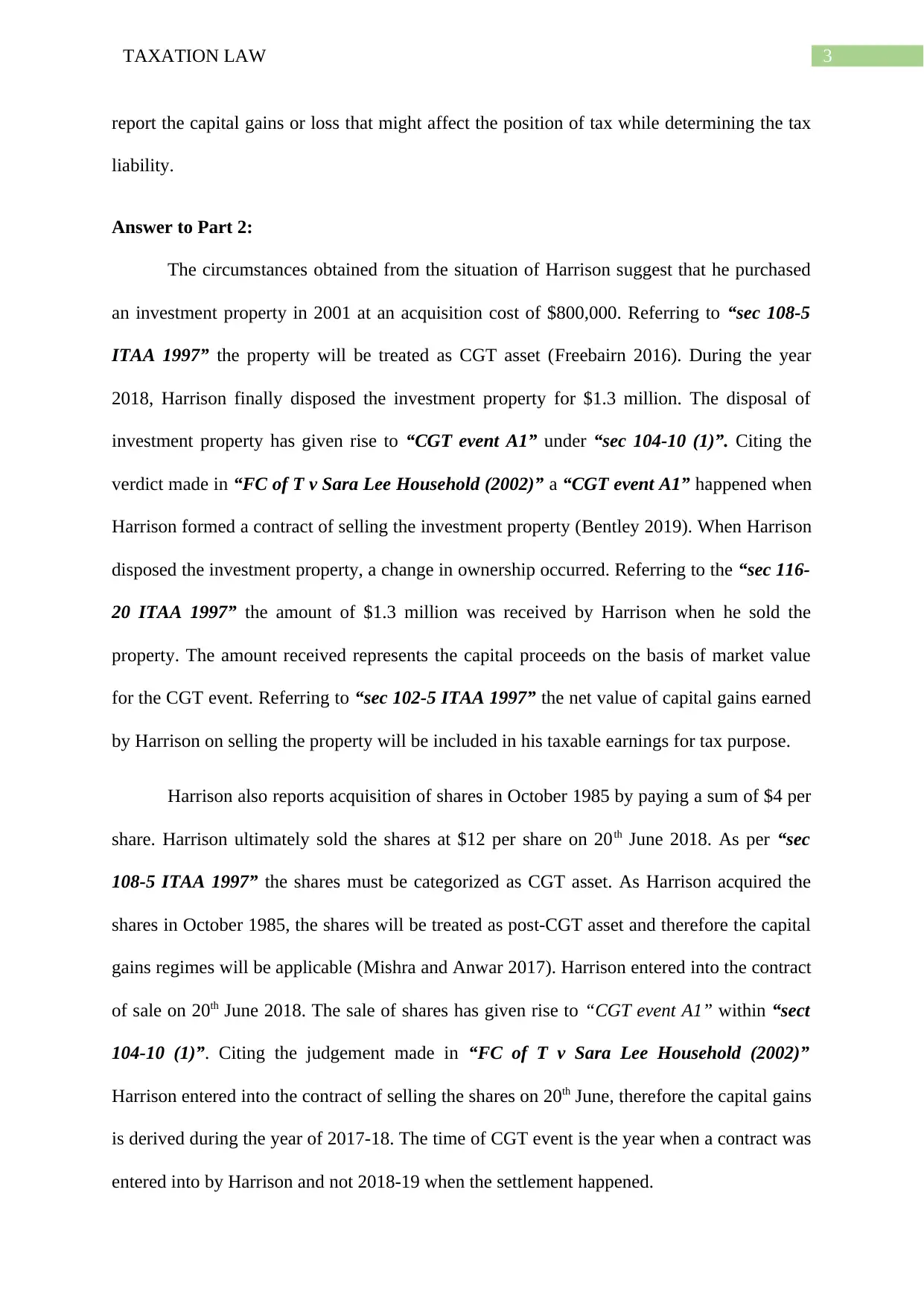
3TAXATION LAW
report the capital gains or loss that might affect the position of tax while determining the tax
liability.
Answer to Part 2:
The circumstances obtained from the situation of Harrison suggest that he purchased
an investment property in 2001 at an acquisition cost of $800,000. Referring to “sec 108-5
ITAA 1997” the property will be treated as CGT asset (Freebairn 2016). During the year
2018, Harrison finally disposed the investment property for $1.3 million. The disposal of
investment property has given rise to “CGT event A1” under “sec 104-10 (1)”. Citing the
verdict made in “FC of T v Sara Lee Household (2002)” a “CGT event A1” happened when
Harrison formed a contract of selling the investment property (Bentley 2019). When Harrison
disposed the investment property, a change in ownership occurred. Referring to the “sec 116-
20 ITAA 1997” the amount of $1.3 million was received by Harrison when he sold the
property. The amount received represents the capital proceeds on the basis of market value
for the CGT event. Referring to “sec 102-5 ITAA 1997” the net value of capital gains earned
by Harrison on selling the property will be included in his taxable earnings for tax purpose.
Harrison also reports acquisition of shares in October 1985 by paying a sum of $4 per
share. Harrison ultimately sold the shares at $12 per share on 20th June 2018. As per “sec
108-5 ITAA 1997” the shares must be categorized as CGT asset. As Harrison acquired the
shares in October 1985, the shares will be treated as post-CGT asset and therefore the capital
gains regimes will be applicable (Mishra and Anwar 2017). Harrison entered into the contract
of sale on 20th June 2018. The sale of shares has given rise to “CGT event A1” within “sect
104-10 (1)”. Citing the judgement made in “FC of T v Sara Lee Household (2002)”
Harrison entered into the contract of selling the shares on 20th June, therefore the capital gains
is derived during the year of 2017-18. The time of CGT event is the year when a contract was
entered into by Harrison and not 2018-19 when the settlement happened.
report the capital gains or loss that might affect the position of tax while determining the tax
liability.
Answer to Part 2:
The circumstances obtained from the situation of Harrison suggest that he purchased
an investment property in 2001 at an acquisition cost of $800,000. Referring to “sec 108-5
ITAA 1997” the property will be treated as CGT asset (Freebairn 2016). During the year
2018, Harrison finally disposed the investment property for $1.3 million. The disposal of
investment property has given rise to “CGT event A1” under “sec 104-10 (1)”. Citing the
verdict made in “FC of T v Sara Lee Household (2002)” a “CGT event A1” happened when
Harrison formed a contract of selling the investment property (Bentley 2019). When Harrison
disposed the investment property, a change in ownership occurred. Referring to the “sec 116-
20 ITAA 1997” the amount of $1.3 million was received by Harrison when he sold the
property. The amount received represents the capital proceeds on the basis of market value
for the CGT event. Referring to “sec 102-5 ITAA 1997” the net value of capital gains earned
by Harrison on selling the property will be included in his taxable earnings for tax purpose.
Harrison also reports acquisition of shares in October 1985 by paying a sum of $4 per
share. Harrison ultimately sold the shares at $12 per share on 20th June 2018. As per “sec
108-5 ITAA 1997” the shares must be categorized as CGT asset. As Harrison acquired the
shares in October 1985, the shares will be treated as post-CGT asset and therefore the capital
gains regimes will be applicable (Mishra and Anwar 2017). Harrison entered into the contract
of sale on 20th June 2018. The sale of shares has given rise to “CGT event A1” within “sect
104-10 (1)”. Citing the judgement made in “FC of T v Sara Lee Household (2002)”
Harrison entered into the contract of selling the shares on 20th June, therefore the capital gains
is derived during the year of 2017-18. The time of CGT event is the year when a contract was
entered into by Harrison and not 2018-19 when the settlement happened.
Secure Best Marks with AI Grader
Need help grading? Try our AI Grader for instant feedback on your assignments.
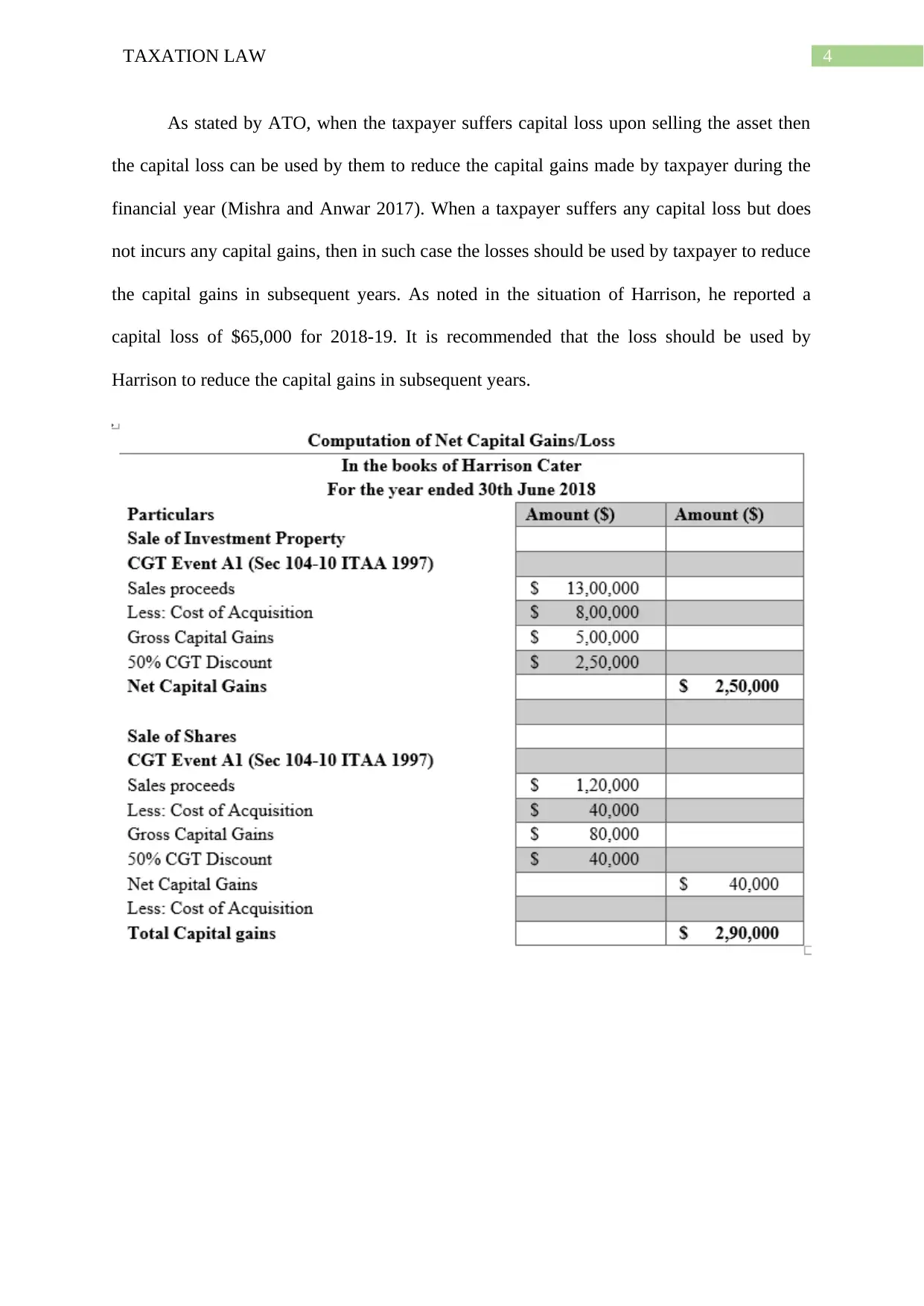
4TAXATION LAW
As stated by ATO, when the taxpayer suffers capital loss upon selling the asset then
the capital loss can be used by them to reduce the capital gains made by taxpayer during the
financial year (Mishra and Anwar 2017). When a taxpayer suffers any capital loss but does
not incurs any capital gains, then in such case the losses should be used by taxpayer to reduce
the capital gains in subsequent years. As noted in the situation of Harrison, he reported a
capital loss of $65,000 for 2018-19. It is recommended that the loss should be used by
Harrison to reduce the capital gains in subsequent years.
As stated by ATO, when the taxpayer suffers capital loss upon selling the asset then
the capital loss can be used by them to reduce the capital gains made by taxpayer during the
financial year (Mishra and Anwar 2017). When a taxpayer suffers any capital loss but does
not incurs any capital gains, then in such case the losses should be used by taxpayer to reduce
the capital gains in subsequent years. As noted in the situation of Harrison, he reported a
capital loss of $65,000 for 2018-19. It is recommended that the loss should be used by
Harrison to reduce the capital gains in subsequent years.
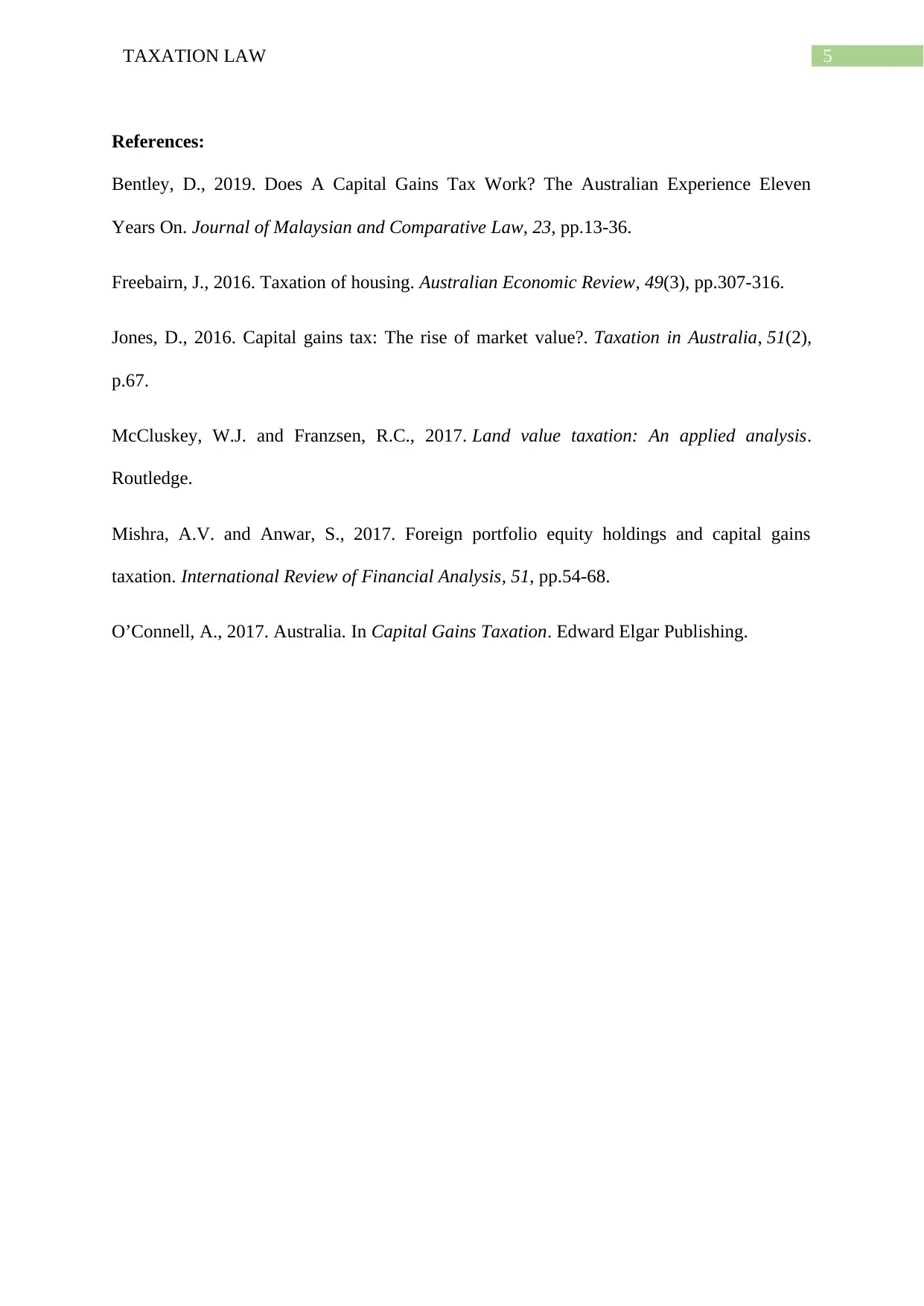
5TAXATION LAW
References:
Bentley, D., 2019. Does A Capital Gains Tax Work? The Australian Experience Eleven
Years On. Journal of Malaysian and Comparative Law, 23, pp.13-36.
Freebairn, J., 2016. Taxation of housing. Australian Economic Review, 49(3), pp.307-316.
Jones, D., 2016. Capital gains tax: The rise of market value?. Taxation in Australia, 51(2),
p.67.
McCluskey, W.J. and Franzsen, R.C., 2017. Land value taxation: An applied analysis.
Routledge.
Mishra, A.V. and Anwar, S., 2017. Foreign portfolio equity holdings and capital gains
taxation. International Review of Financial Analysis, 51, pp.54-68.
O’Connell, A., 2017. Australia. In Capital Gains Taxation. Edward Elgar Publishing.
References:
Bentley, D., 2019. Does A Capital Gains Tax Work? The Australian Experience Eleven
Years On. Journal of Malaysian and Comparative Law, 23, pp.13-36.
Freebairn, J., 2016. Taxation of housing. Australian Economic Review, 49(3), pp.307-316.
Jones, D., 2016. Capital gains tax: The rise of market value?. Taxation in Australia, 51(2),
p.67.
McCluskey, W.J. and Franzsen, R.C., 2017. Land value taxation: An applied analysis.
Routledge.
Mishra, A.V. and Anwar, S., 2017. Foreign portfolio equity holdings and capital gains
taxation. International Review of Financial Analysis, 51, pp.54-68.
O’Connell, A., 2017. Australia. In Capital Gains Taxation. Edward Elgar Publishing.
1 out of 6
Related Documents
Your All-in-One AI-Powered Toolkit for Academic Success.
+13062052269
info@desklib.com
Available 24*7 on WhatsApp / Email
![[object Object]](/_next/static/media/star-bottom.7253800d.svg)
Unlock your academic potential
© 2024 | Zucol Services PVT LTD | All rights reserved.





